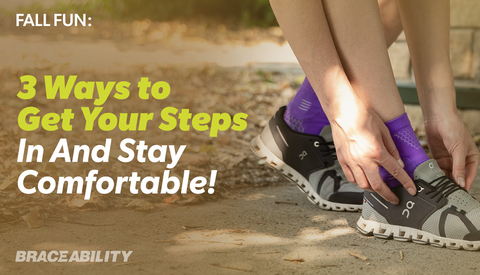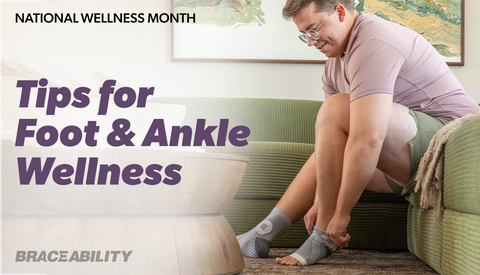Discover Plantar Fasciitis Pain Relief That Lasts all Day and Night
Managing Plantar Fasciitis Pain with NEW! Insoles
If you're struggling with the stabbing heel pain of plantar fasciitis, you know it's not just a morning problem, it can affect every step you take throughout your day. From getting out of bed to walking at work, running errands, and trying to sleep comfortably at night, managing plantar fasciitis requires a full-day support strategy.
The good news? Relief is possible when you treat your plantar fascia with purpose during every part of your day. Here’s how to combine supportive gear and simple lifestyle changes to manage plantar fasciitis pain from sunrise to sleep, and feel better every step of the way.
Morning: Wake Up Without That First-Step Pain
Plantar fasciitis pain often strikes hardest in the morning. That’s because your plantar fascia tightens overnight, and when you take your first steps, the sudden stretch causes sharp heel pain. But with the right preparation and morning habits, you can prevent that dreaded discomfort.
What to Wear at Night: Plantar Fasciitis Night Sock Splint
One of the most effective ways to reduce morning foot pain is to wear a Plantar Fasciitis Night Sock Splint while you sleep. This holds the foot flexed (toes toward shin) and keeps the plantar fascia gently stretched overnight, which prevents it from tightening and causing severe morning pain (health.harvard.edu).
What makes this night splint a game-changer:
-
Soft, breathable materials for comfortable sleep
-
Non-slip tread for safe late-night trips to the bathroom
-
Adjustable dorsiflexion strap for a custom stretch
-
Open-heel design for airflow and minimal bulk
Pro Tip: If you’re new to night splints, start by wearing it for part of the night and gradually increase as you get used to the stretch. Consistency is key to reducing that morning pain.
Morning Routine Tips:
-
Stretch before you get out of bed. Try simple seated towel stretches or ankle pumps to warm up your fascia.
-
Roll it out. Use a frozen water bottle or massage ball under your arch to reduce inflammation and promote flexibility.
-
Take your time standing. Ease into your day by slowly transitioning from sitting to standing, giving your fascia time to adjust.
Daytime: Stay Comfortable on Your Feet with This Insole
As you move through your day, whether you're walking at work, running errands, or chasing kids around the house, ongoing support is critical. Every step puts pressure on your heel and arch, so what you wear in your shoes and on your feet makes a major difference.
What to Wear During the Day: NEW! Plantar Fasciitis Insoles
Support starts from the ground up, and BraceAbility’s Plantar Fasciitis Insoles are designed to do just that. These insoles are built with a high-density foam base and a firm TPU arch to correct your alignment, cushion your heel, and distribute pressure evenly across your foot.
These provide firm arch support and heel padding, which help distribute your weight evenly and reduce stress on the plantar fascia. Insoles designed for plantar fasciitis often have a slight heel lift and gel cushions to absorb shock (health.harvard.ed).
Perfect for slipping into everyday shoes, these insoles provide:
-
Balanced arch support for high, normal, or flat arches
-
Heel and forefoot gel cushioning to absorb shock
-
Trim-to-fit sizing for a custom shoe fit
-
Ergonomic heel cup for added stability
Pro Tip: Replace the factory insoles in your sneakers or work shoes with these PF insoles for a huge upgrade in support and shock absorption.
Extra Support for Long Days: Plantar Fasciitis Relief Socks
For added compression, slip on the Plantar Fasciitis Relief Socks under your shoes. These all-day socks offer:
-
Built-in compression zones targeting the arch, heel, and ankle
-
Full-toe design for sock-like wear without needing layers
-
Heel cushioning to reduce impact during standing or walking
-
Breathe-Fit™ fabric to wick moisture and reduce odor
Compression socks are especially helpful if your day involves long hours on your feet, walking on hard surfaces, or standing in one place for too long. They help fight swelling, improve circulation, and keep pain at bay without feeling bulky.
Pro Tip: These socks can be worn alone around the house or with insoles in your shoes, great for people who don’t want to deal with braces but still need ongoing support.
Midday Tips for Managing Pain:
-
Take stretch breaks. Calf stretches or standing wall stretches help keep your Achilles and plantar fascia from tightening.
-
Avoid barefoot walking. Even indoors, wear supportive shoes or slippers with arch support.
-
Switch positions. Alternate between sitting and standing every hour to reduce pressure buildup.
Evening: Recovery Mode On
Once the day winds down, it’s time to shift your focus to rest, recovery, and preparing your feet for another pain-free day tomorrow.
Evening Routine Tips:
-
Stretch before dinner or bed. Use a step or wall to stretch your calves and Achilles tendon.
-
Roll out tension. Use a massage ball, frozen bottle, or foam roller to relax tight muscles.
-
Elevate your feet. Reducing swelling helps ease inflammation and improve circulation.
What to Wear for Recovery:
In the evening, swap out your daytime shoes and opt for supportive sandals or slippers that still offer arch support. If you're planning to be barefoot, at least wear your Plantar Fasciitis Relief Socks to keep compression on the problem areas.
As bedtime approaches, slip back into your Night Sock Splint to restart the healing process while you sleep.
Pro Tip: The more consistent you are with nighttime stretching and compression, the better your mornings will feel. Skipping even one night can set you back in your healing progress.
Real-Life Recovery: Pairing Products with Purpose
Let’s break down a simple daily routine using all three plantar fasciitis supports:
|
Time of Day |
Wear This |
Why It Helps |
|
Morning (upon waking) |
None at first; ease into movement |
Prevents sudden overstretching of fascia |
|
Early morning |
Stretch + roll foot |
Loosens tissue before bearing weight |
|
All day (on feet) |
Cushion, align, compress, and support through all activities |
|
|
Evening (at home) |
Maintain light compression and heel support |
|
|
Night (while sleeping) |
Provides a sustained stretch to reduce morning pain |
This schedule helps you manage symptoms proactively and prevent flare-ups before they start.
Final Tips for All-Day PF Pain Management
Plantar fasciitis isn’t always quick to heal, but daily consistency is the key to recovery. Use this time-based approach to support your fascia around the clock:
-
Stay consistent. Wear your braces daily, even if you’re feeling better.
-
Combine tools. Don’t rely on just one product, layer your support throughout the day.
-
Stretch smart. Morning, midday, and night stretching keeps the tissue mobile.
-
Be patient. Most people see results within weeks or months, but consistency is everything.
Whether you're battling chronic pain or a sudden flare-up, this daily approach using BraceAbility’s Plantar Fasciitis Insoles, Relief Socks, and Night Sock Splint offers a simple but powerful way to take control of your pain.













